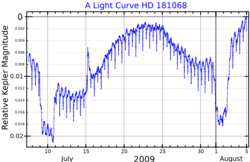HD 181068
Star system in the constellation Lyra From Wikipedia, the free encyclopedia
HD 181068 is a star system in the constellation of Lyra. With an apparent magnitude of 7.09,[3] the system is not visible to the naked eye but may be viewed with a pair of binoculars. Based on parallax measurements made by the Hipparcos spacecraft, the system is some 810 light years (250 parsecs) away from Earth.[2]
| Observation data Epoch J2000 Equinox J2000 | |
|---|---|
| Constellation | Lyra |
| Right ascension | 19h 17m 08.97863s[2] |
| Declination | +41° 15′ 53.3103″[2] |
| Apparent magnitude (V) | 7.09[3] |
| Characteristics | |
| Spectral type | G8III / G8V / K1V[1] |
| Variable type | Eclipsing binary |
| Astrometry | |
| Radial velocity (Rv) | 5.83 km/s |
| Proper motion (μ) | RA: 0.60[2] mas/yr Dec.: -8.07[2] mas/yr |
| Parallax (π) | 4.02±0.40 mas[2] |
| Distance | 810 ± 80 ly (250 ± 20 pc) |
| Absolute magnitude (MV) | –0.3 / 5.6 / 6.1[1] |
| Orbit[4] | |
| Primary | HD 181068 A |
| Companion | HD 181068 B |
| Period (P) | 45.4711 ± 0.0002 d |
| Semi-major axis (a) | 90.31 ± 0.72 R☉ |
| Eccentricity (e) | 0 |
| Inclination (i) | 87.5 ± 2° |
| Periastron epoch (T) | Tmin = 2455499.9962 |
| Orbit[4] | |
| Primary | HD 181068 Ba |
| Companion | HD 181068 Bb |
| Period (P) | 0.9056768 ± 0.0000002 d |
| Semi-major axis (a) | 4.777 ± 0.039 R☉ |
| Eccentricity (e) | 0 |
| Inclination (i) | 87.6 ± 1.4° |
| Periastron epoch (T) | Tmin = 2455051.23623 |
| Details[5] | |
| HD 181068 A | |
| Mass | 3 ± 0.1 M☉ |
| Radius | 12.46 ± 0.15 R☉ |
| Luminosity (bolometric) | 92.8 ± 7.6 L☉ |
| Surface gravity (log g) | 2.73 cgs |
| Temperature | 5100 ± 100 K |
| HD 181068 Ba | |
| Mass | 0.915 ± 0.034 M☉ |
| Radius | 0.865 ± 0.01 R☉ |
| Luminosity (bolometric) | 0.447 ± 0.037 L☉ |
| Surface gravity (log g) | 4.53 cgs |
| Temperature | 5100 ± 100 K |
| HD 181068 Bb | |
| Mass | 0.870 ± 0.043 M☉ |
| Radius | 0.8 ± 0.02 R☉ |
| Luminosity (bolometric) | 0.27 ± 0.027 L☉ |
| Surface gravity (log g) | 4.58 cgs |
| Temperature | 4675 ± 100 K |
| Other designations | |
| HD 181068, BD+41° 3292, HIP 94780, SAO 48282, KIC 5952403[6] | |
| Database references | |
| SIMBAD | data |
| KIC | data |
HD 181068 is in the Kepler spacecraft's field of view, and its unique properties were first observed by the satellite's photometer. It consists of a red giant, designated HD 181068 A, along with two main-sequence stars, designated HD 181068 Ba and HD 181068 Bb, respectively. Normal eclipsing binaries have two components that pass in front of each other while eclipsing. However, all three components of HD 181068 orbit each other in such a way that they eclipse each other, forming a rare triply eclipsing system.[7]
The primary, HD 181068 A, has a spectral type of G8III,[1] meaning it is a red giant that has used up its core hydrogen and has expanded to a radius of 12.46 R☉.[5] The primary star is also unusual in that it does not exhibit internal seismic oscillations as have been detected in other red giants, although tidal forces from the closer pair may possibly be causing other variability in the light curve of the system.[7]
HD 181068 Ba and Bb have spectral types of G8V and K1V respectively, indicating their location on the main sequence, slightly later than the Sun. They are in a close orbit and complete an orbit once every 0.906 days (about 21.7 hours), while they orbit HD 181068 A every 45.5 days.[4] All three stars have similar surface brightnesses and colors, so when the two companions eclipse the red giant, the change in brightness is very slight and hard to detect.[7]
See also
References
Wikiwand - on
Seamless Wikipedia browsing. On steroids.

